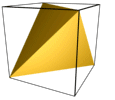Tetrahedron
Tetrahedron is a type of polyhedron that has four triangular faces, six straight edges, and four vertex corners. The tetrahedron is the simplest of all the ordinary convex polyhedra and the only one that has fewer than 5 faces. It belongs to the Platonic solids family, a group of polyhedra that are highly symmetrical, being composed of faces with the same shape and size, and identical vertices.
Properties[edit | edit source]
A tetrahedron is characterized by several unique properties. It is the only Platonic solid that does not have parallel faces. Each vertex of a tetrahedron is connected to the other three vertices by an edge, and the angles between these edges determine the shape of the tetrahedron. If all the edge lengths are equal, the tetrahedron is called a regular tetrahedron, and its faces are equilateral triangles. In a regular tetrahedron, the angle between any two faces is approximately 70.53 degrees.
The volume V of a tetrahedron, given its edge length a, can be calculated using the formula: \[V = \frac{a^3}{6\sqrt{2}}\] This formula highlights the efficiency of the tetrahedron's shape in enclosing space relative to its surface area.
Applications[edit | edit source]
Tetrahedrons have applications in various fields such as chemistry, where the molecular shape of many compounds, such as methane (CH4), is tetrahedral. In architecture and structural engineering, tetrahedral shapes are valued for their strength and are used in the design of trusses and frameworks. The tetrahedron is also found in computer graphics and 3D modeling, where it is used in the mathematical representation of physical forms and in the development of mesh and grid structures.
Dual Polyhedron[edit | edit source]
The dual of a tetrahedron is another tetrahedron. This duality means that a tetrahedron can be inscribed in another tetrahedron, where the vertices of one correspond to the faces of the other and vice versa. This property is unique among the Platonic solids, as the dual of any other Platonic solid is a different solid.
Symmetry[edit | edit source]
The symmetry group of a regular tetrahedron is the tetrahedral symmetry group, denoted as Td. This group includes rotations and reflections that map the tetrahedron onto itself. The regular tetrahedron has 12 rotational symmetries and 12 reflection symmetries, making for a total of 24 symmetries.
See Also[edit | edit source]
This article is a mathematics-related stub. You can help WikiMD by expanding it!
Search WikiMD
Ad.Tired of being Overweight? Try W8MD's NYC physician weight loss.
Semaglutide (Ozempic / Wegovy and Tirzepatide (Mounjaro / Zepbound) available. Call 718 946 5500.
Advertise on WikiMD
|
WikiMD's Wellness Encyclopedia |
| Let Food Be Thy Medicine Medicine Thy Food - Hippocrates |
Translate this page: - East Asian
中文,
日本,
한국어,
South Asian
हिन्दी,
தமிழ்,
తెలుగు,
Urdu,
ಕನ್ನಡ,
Southeast Asian
Indonesian,
Vietnamese,
Thai,
မြန်မာဘာသာ,
বাংলা
European
español,
Deutsch,
français,
Greek,
português do Brasil,
polski,
română,
русский,
Nederlands,
norsk,
svenska,
suomi,
Italian
Middle Eastern & African
عربى,
Turkish,
Persian,
Hebrew,
Afrikaans,
isiZulu,
Kiswahili,
Other
Bulgarian,
Hungarian,
Czech,
Swedish,
മലയാളം,
मराठी,
ਪੰਜਾਬੀ,
ગુજરાતી,
Portuguese,
Ukrainian
Medical Disclaimer: WikiMD is not a substitute for professional medical advice. The information on WikiMD is provided as an information resource only, may be incorrect, outdated or misleading, and is not to be used or relied on for any diagnostic or treatment purposes. Please consult your health care provider before making any healthcare decisions or for guidance about a specific medical condition. WikiMD expressly disclaims responsibility, and shall have no liability, for any damages, loss, injury, or liability whatsoever suffered as a result of your reliance on the information contained in this site. By visiting this site you agree to the foregoing terms and conditions, which may from time to time be changed or supplemented by WikiMD. If you do not agree to the foregoing terms and conditions, you should not enter or use this site. See full disclaimer.
Credits:Most images are courtesy of Wikimedia commons, and templates, categories Wikipedia, licensed under CC BY SA or similar.
Contributors: Prab R. Tumpati, MD





